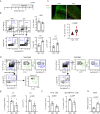Langerhans cells shape postnatal oral homeostasis in a mechanical-force-dependent but microbiota and IL17-independent manner
- PMID: 37699897
- PMCID: PMC10497507
- DOI: 10.1038/s41467-023-41409-0
Langerhans cells shape postnatal oral homeostasis in a mechanical-force-dependent but microbiota and IL17-independent manner
Abstract
The postnatal interaction between microbiota and the immune system establishes lifelong homeostasis at mucosal epithelial barriers, however, the barrier-specific physiological activities that drive the equilibrium are hardly known. During weaning, the oral epithelium, which is monitored by Langerhans cells (LC), is challenged by the development of a microbial plaque and the initiation of masticatory forces capable of damaging the epithelium. Here we show that microbial colonization following birth facilitates the differentiation of oral LCs, setting the stage for the weaning period, in which adaptive immunity develops. Despite the presence of the challenging microbial plaque, LCs mainly respond to masticatory mechanical forces, inducing adaptive immunity, to maintain epithelial integrity that is also associated with naturally occurring alveolar bone loss. Mechanistically, masticatory forces induce the migration of LCs to the lymph nodes, and in return, LCs support the development of immunity to maintain epithelial integrity in a microbiota-independent manner. Unlike in adult life, this bone loss is IL-17-independent, suggesting that the establishment of oral mucosal homeostasis after birth and its maintenance in adult life involve distinct mechanisms.
© 2023. Springer Nature Limited.
Conflict of interest statement
The authors declare no competing interests.
Figures








Similar articles
-
Mucosal Langerhans Cells Promote Differentiation of Th17 Cells in a Murine Model of Periodontitis but Are Not Required for Porphyromonas gingivalis-Driven Alveolar Bone Destruction.J Immunol. 2016 Aug 15;197(4):1435-46. doi: 10.4049/jimmunol.1502693. Epub 2016 Jul 11. J Immunol. 2016. PMID: 27402698 Free PMC article.
-
Sequential BMP7/TGF-β1 signaling and microbiota instruct mucosal Langerhans cell differentiation.J Exp Med. 2018 Feb 5;215(2):481-500. doi: 10.1084/jem.20171508. Epub 2018 Jan 17. J Exp Med. 2018. PMID: 29343501 Free PMC article.
-
Niche rather than origin dysregulates mucosal Langerhans cells development in aged mice.Mucosal Immunol. 2020 Sep;13(5):767-776. doi: 10.1038/s41385-020-0301-y. Epub 2020 May 26. Mucosal Immunol. 2020. PMID: 32457449
-
[Research Updates: The Role of Interaction between Oral Microbiota, Immune Cells, and Epithelial Barrier in Oral Mucosal Homeostasis and Pathogenesis].Sichuan Da Xue Xue Bao Yi Xue Ban. 2022 Mar;53(2):188-193. doi: 10.12182/20220360501. Sichuan Da Xue Xue Bao Yi Xue Ban. 2022. PMID: 35332716 Free PMC article. Review. Chinese.
-
Shaped by the epithelium - postnatal immune mechanisms of oral homeostasis.Trends Immunol. 2021 Jul;42(7):622-634. doi: 10.1016/j.it.2021.05.006. Epub 2021 May 31. Trends Immunol. 2021. PMID: 34083119 Review.
Cited by
-
An update on periodontal inflammation and bone loss.Front Immunol. 2024 Jun 11;15:1385436. doi: 10.3389/fimmu.2024.1385436. eCollection 2024. Front Immunol. 2024. PMID: 38919613 Free PMC article. Review.
-
Convergent evolution of monocyte differentiation in adult skin instructs Langerhans cell identity.Sci Immunol. 2024 Sep 6;9(99):eadp0344. doi: 10.1126/sciimmunol.adp0344. Epub 2024 Sep 6. Sci Immunol. 2024. PMID: 39241057 Free PMC article.
-
The role of the epithelial sentinels, Langerhans cells and γδT cells, in oral squamous cell carcinoma.Periodontol 2000. 2024 Oct;96(1):221-228. doi: 10.1111/prd.12544. Epub 2024 Jan 25. Periodontol 2000. 2024. PMID: 38273461 Free PMC article. Review.
-
Epithelial RANKL Limits Experimental Periodontitis via Langerhans Cells.J Dent Res. 2024 Nov;103(12):1281-1290. doi: 10.1177/00220345241274370. Epub 2024 Oct 6. J Dent Res. 2024. PMID: 39370697 Free PMC article.
-
Gingival spatial analysis reveals geographic immunological variation in a microbiota-dependent and -independent manner.NPJ Biofilms Microbiomes. 2024 Dec 3;10(1):142. doi: 10.1038/s41522-024-00625-2. NPJ Biofilms Microbiomes. 2024. PMID: 39627243 Free PMC article.
References
-
- Zubeidat K. & Hovav A. H. Shaped by the epithelium - postnatal immune mechanisms of oral homeostasis. Trends Immunol. 42, 622–634 (2021). - PubMed
Publication types
MeSH terms
Substances
LinkOut - more resources
Full Text Sources
Molecular Biology Databases

